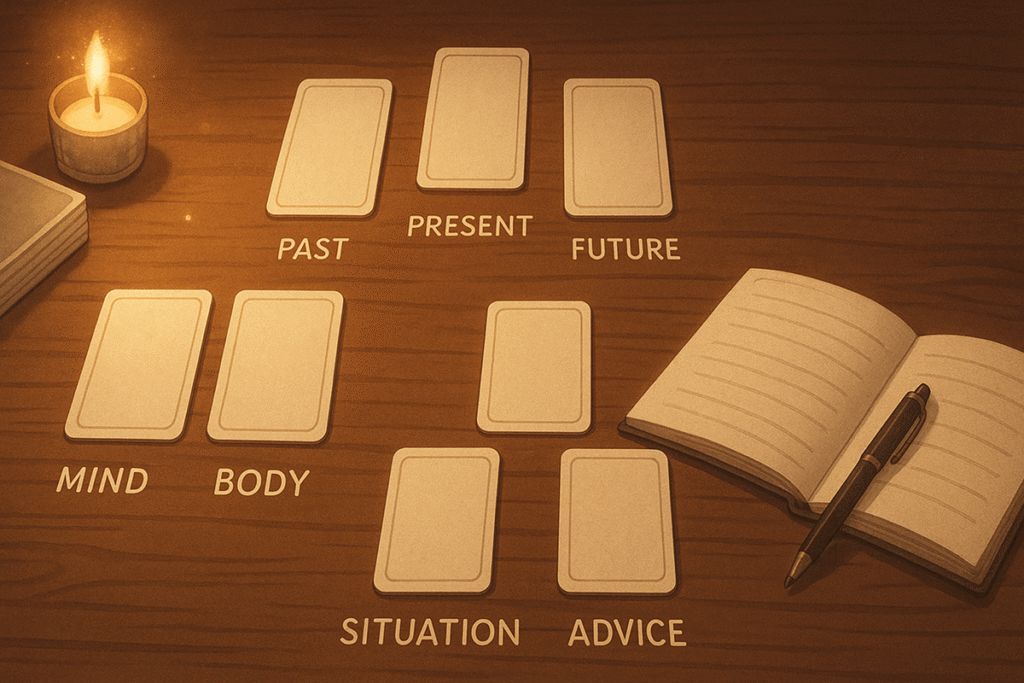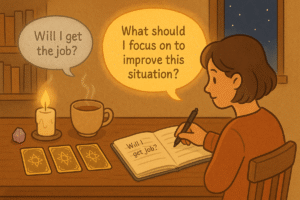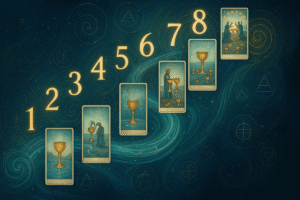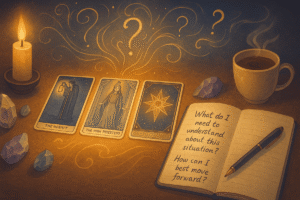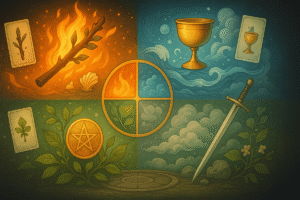Table of Contents
Starting your tarot journey can feel overwhelming when you’re staring at 78 cards and wondering where to begin. I remember my first deck sitting on my nightstand for weeks before I finally worked up the courage to actually shuffle them. The good news? You don’t need to master complex spreads or memorize every card meaning to start connecting with tarot in meaningful ways.
Simple tarot spreads are your gateway into this fascinating practice. They offer structure without complexity, guidance without overwhelm. Think of them as training wheels for your intuitive development. These layouts help you focus your questions, organize your thoughts, and begin recognizing patterns in the cards that speak to your personal journey.
What makes a spread truly beginner-friendly isn’t just the number of cards involved. It’s about clarity of purpose, ease of interpretation, and the ability to practice regularly without feeling intimidated. The spreads we’ll explore today tick all these boxes while offering genuine insight into your daily experiences and inner landscape.
Why Simple Spreads Work Better for New Readers
Complex spreads with ten or twelve cards might look impressive, but they often create more confusion than clarity for beginners. When you’re still learning to interpret individual cards, adding multiple layers of positional meanings can muddy the waters considerably.
Simple spreads allow you to focus on the essential skill of card interpretation without getting lost in elaborate frameworks. You’ll spend more time actually connecting with the imagery and symbolism rather than trying to remember what position seven is supposed to represent.
There’s also something to be said for building confidence gradually. Successfully completing a three-card reading gives you a sense of accomplishment that encourages continued practice. Perhaps more importantly, simple spreads teach you to trust your intuition without relying on overly structured interpretations.
I’ve noticed that many experienced readers actually return to simple spreads regularly. They’re not just stepping stones to more complex work; they’re powerful tools in their own right. Sometimes the most profound insights come from the most straightforward approaches.
The One-Card Daily Draw
Before diving into multi-card spreads, let’s start with the foundation of tarot practice. The daily card draw is deceptively simple yet remarkably effective for developing your relationship with the deck.
Each morning, shuffle your cards while thinking about the day ahead. Draw one card and spend a few minutes contemplating its imagery and energy. What themes does it suggest? What aspects of your day might it be highlighting? Don’t worry about getting the “right” interpretation. Focus instead on what the card makes you think about or feel.
The beauty of this practice lies in its consistency rather than complexity. Over time, you’ll begin noticing how certain cards appear when specific situations arise in your life. You might draw the Three of Cups before social gatherings or find the Eight of Pentacles showing up during busy work periods.
Keep a simple journal of your daily draws if possible. Even just noting the card name and one or two thoughts can help you track patterns. This practice alone will accelerate your learning more than memorizing card meanings from books.
Some days your daily card might feel completely irrelevant. That’s perfectly normal and often more meaningful than it initially appears. Sometimes the cards reflect internal states we’re not consciously aware of, or they point toward possibilities we haven’t yet considered.
The Three-Card Past, Present, Future Spread
This classic layout forms the backbone of tarot reading for good reason. It’s intuitive, versatile, and offers just enough information to be helpful without becoming overwhelming. The three positions create a natural narrative flow that mirrors how we naturally think about our experiences.
Place three cards in a row from left to right. The first card represents influences from your past that are affecting your current situation. The middle card shows your present circumstances or state of mind. The final card suggests potential outcomes or future developments.
What I find particularly helpful about this spread is how it encourages you to see connections between your experiences. The past card doesn’t just represent what happened; it shows how those experiences are still influencing your present moment. Similarly, the future card isn’t a fixed prediction but rather a glimpse of where your current path might lead.
When interpreting this spread, start by looking at each card individually. What story does each one tell? Then step back and observe the relationships between them. Do the cards seem to flow naturally from one to the next, or do you see tension and contrast? Both patterns offer valuable insights.
Sometimes the past and future cards feel more relevant than the present card. This often happens when we’re in transition periods or when we’re not fully present in our current circumstances. The cards have a way of highlighting what we need to pay attention to, even when it’s not what we expected to see.
The Situation and Advice Spread
This two-card spread might seem almost too simple, but its effectiveness lies in its direct approach to problem-solving and decision-making. When you’re facing a specific challenge or question, this layout cuts straight to the heart of the matter.
Draw two cards side by side. The first card represents your current situation or the nature of your question. The second card offers guidance or suggests an approach to consider. The beauty of this spread is how it separates assessment from action, helping you see your circumstances more clearly before jumping to solutions.
I’ve found this spread particularly useful for everyday dilemmas that don’t require extensive analysis. Should you have that difficult conversation with a friend? What energy should you bring to an important meeting? How might you approach a creative project that’s been stalled?
The situation card often reveals aspects of your question that you hadn’t fully considered. You might ask about a work conflict and draw a card that points toward deeper issues of communication or self-worth. This added perspective can completely shift how you approach the problem.
The advice card doesn’t tell you what will happen; it suggests qualities to embody or directions to explore. Think of it as a wise friend offering perspective rather than a fortune teller predicting outcomes. This framing keeps you in the driver’s seat of your own decisions while providing valuable guidance.
The Mind, Body, Spirit Check-In
This three-card spread offers a holistic view of your current well-being across different aspects of your experience. It’s particularly valuable during stressful periods or when you’re feeling out of balance but can’t quite pinpoint why.
Lay out three cards in whatever formation feels right to you. Some people prefer a triangle, others a straight line. The positions represent your mental state, physical condition, and spiritual or emotional energy respectively.
The mind card reveals your current thought patterns, mental preoccupations, or intellectual challenges. Are you overthinking? Feeling mentally scattered? Or perhaps you’re in a phase of clear focus and determination? This card helps you recognize mental habits that might be supporting or hindering your well-being.
Your body card connects to your physical experience and relationship with your material world. This might relate to health, energy levels, or how you’re engaging with practical matters in your life. Sometimes this card points toward the need for rest, movement, better nutrition, or simply paying more attention to physical signals you’ve been ignoring.
The spirit card addresses your emotional landscape and connection to meaning or purpose. What’s feeding your soul right now? Where might you need more inspiration or connection? This position often reveals needs that get overlooked in busy daily life but are essential for overall balance.
What makes this spread particularly valuable is how it encourages you to consider all aspects of your experience rather than focusing on just one area. Often we try to solve emotional problems with mental solutions or address spiritual needs through physical changes. This spread helps you see the bigger picture.
The Challenge and Growth Spread
Sometimes we need guidance not about what to do, but about how to grow through difficult experiences. This two-card spread acknowledges that challenges often carry hidden gifts, even when they’re genuinely difficult to navigate.
The first card represents your current challenge or the obstacle you’re facing. Rather than seeing this as purely negative, approach it as information about what you’re being asked to work with right now. What themes does this card suggest? What qualities or skills might this situation be calling forth?
The second card points toward the potential growth or learning available within this challenge. This isn’t about silver linings or pretending difficulties aren’t real. Instead, it’s about recognizing that our struggles often push us to develop strengths we didn’t know we possessed.
I think this spread works particularly well because it honors both the reality of difficulty and the possibility of transformation. Neither perspective is complete on its own, but together they offer a more nuanced view of challenging circumstances.
The growth card might suggest qualities to cultivate, perspectives to consider, or support systems to engage. Sometimes it reveals that your challenge is actually preparing you for opportunities that haven’t yet appeared. Other times it simply reminds you of strengths you already possess but haven’t been using.
Building Your Daily Practice
The key to developing your tarot skills lies not in reading for others or tackling complex spreads, but in consistent personal practice with simple layouts. These five spreads provide enough variety to keep your practice interesting while remaining accessible enough for regular use.
Consider rotating between different spreads based on your needs and energy levels. Some days might call for the straightforward clarity of the situation and advice spread. Other times you might need the broader perspective of the mind, body, spirit check-in.
Remember that tarot reading is a skill that develops over time through practice and reflection. Your interpretations will deepen naturally as you spend more time with the cards and begin recognizing recurring themes in your readings. Trust your instincts, stay curious about what the cards might be suggesting, and don’t worry about being perfect.
These simple spreads aren’t just training exercises; they’re powerful tools for self-reflection and guidance that will serve you well throughout your tarot journey. Start with whichever spread feels most appealing, and let your practice evolve organically from there.
Frequently Asked Questions
How often should I practice with tarot spreads as a beginner?
Daily practice is the most effective way to build your tarot skills. Even pulling just one card each day helps you become familiar with the deck and develop your interpretive abilities. Keeping a simple journal of your daily draws can help you track patterns and accelerate your learning. The consistency matters more than the complexity of the spread you choose. Start with what feels manageable for your schedule, whether that’s daily single card draws or weekly three card readings.
Do I need to read reversed cards when I’m just starting out?
Reversals are entirely a matter of personal preference, and many experienced readers don’t use them at all while still conducting excellent readings. As a beginner, you might find it simpler to focus on upright interpretations first. If you do want to include reversals, certain shuffling methods like swirling cards face down on a surface naturally introduce them. There’s no pressure to use reversed meanings until you feel ready.
Can I create my own tarot spreads or should I stick to traditional ones?
Creating your own spreads can be as simple as preparing a few related questions and pulling one card for each question. Once you’re comfortable with the basic spreads covered here, feel free to adapt them to your needs. The most important thing is that the spread makes sense to you and feels easy to work with. Many experienced readers started with traditional spreads and gradually developed their own variations based on what worked best for their reading style.
How do I know which shuffling method is right for me?
The best approach is to try different shuffling methods and see which one or two feel most natural to you. Some people prefer the overhand shuffle for its simplicity, while others enjoy the meditative quality of swirling cards on a table. The point of shuffling is not just to mix the cards but to blend your energy and intention with the deck. Choose whatever method allows you to focus on your question while feeling comfortable and connected to the cards.

